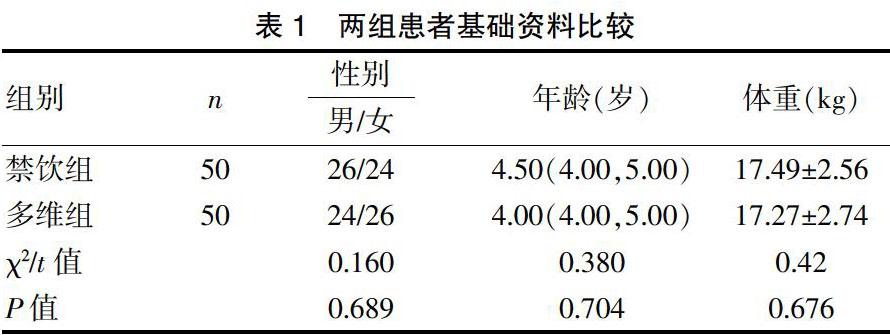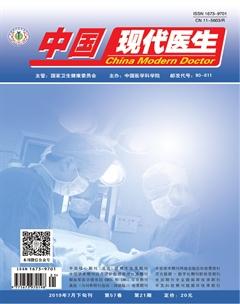B超探测胃内残余量分析两种禁饮禁食方式对斜视手术儿童的影响
陈超巧 金约西 程丹 卓然 姜爱芬



[摘要] 目的 利用B超探测胃内残余量分析两种禁食方式对斜视手术儿童的影响。 方法 选取本院2017年6月~2018年6月需全麻下行斜视矫正术3~6岁儿童100例,随机数字表法分为禁饮组与多维组,各50例。两组术前8 h禁食固体食物,禁饮组术前4 h禁止清饮,多维组术前2 h饮用5 mL/kg的多维饮料。两组均在麻醉前2 h及麻醉后即刻B超测定胃内残量;术前以及术后3 h测量血糖、胰岛素;麻醉前记录饥饿感指数;麻醉后记录患儿苏醒质量。 结果 B超探测两组麻醉前2 h胃内残余量(多维饮料组在口服饮料之前),以及麻醉以后即刻查胃内残余量都无统计学差异(P>0.05),多维组患儿饥饿感评分降低(P<0.001);血糖及胰岛素比较,麻醉前,多维组高于禁饮组,而术毕禁饮组血糖胰岛素水平明显高于多维组(P<0.001),两组术后血糖胰岛素水平无差异(P>0.05);苏醒质量、排气时间及恶心呕吐程度,多维组均优于禁饮组(P<0.001)。 结论 择期全麻斜视矫正手术患儿术前以及术后2 h口服多维饮料,并不增加胃内容量及反流误吸的风险。相反,患儿血糖胰岛素更趋于稳定,减少临床不适。
[关键词] 斜视手术;禁饮禁食;胃内残余量;胰岛素水平
[中图分类号] R779.6 [文獻标识码] B [文章编号] 1673-9701(2019)21-0094-04
Analysis of the effect of two forbidden to drink fast modes on children with strabismus surgery by using B-ultrasound to detect residual amount in the stomach
CHEN Chaoqiao1 JIN Yuexi1 CHENG Dan2 ZHUO Ran3 JIANG Aifen1
1.Department of Anesthesiology, the Eye Hospital of Wenzhou Medical University, Wenzhou 325000, China; 2.Fundus Specialist, the Eye Hospital of Wenzhou Medical University, Wenzhou 325000, China; 3.Strabismus and Amblyopia Specialist, the Eye Hospital of Wenzhou Medical University, Wenzhou 325000, China
[Abstract] Objective To analyze the effect of two fasting methods on children with strabismus surgery by using B-ultrasound to detect residual amount in the stomach. Methods A total of 100 children aged 3-6 years who underwent general anesthesia strabismus correction from June 2017 to June 2018 were enrolled. They were divided into the forbidden to drink group and the multi-dimensional beverage group according to random number table method, with 50 cases in each group. The two groups were forbidden to eat solid food at 8 hours before the operation, and the forbidden to drink group was forbidden to drink at 4 hours before the operation. The multi-dimensional group was given 5 mL/kg of multi-dimensional beverage at 2 hours before surgery. The residual amount in the stomach of two groups was measured by B-ultrasound at 2 hours before anesthesia and immediately after anesthesia. The blood glucose and insulin were measured before and at 3 hours after surgery. The hunger-sensation index was recorded before anesthesia. The quality of recovery was recorded after anesthesia. Results There was no significant difference in the residual amount in the stomach detected by B-ultrasound at 2 hours before anesthesia (before the oral drink in the multi-dimensional beverage group) and immediately after anesthesia between two groups (P>0.05). The hunger-sensation score in the multi-dimensional group was reduced (P<0.001). Before the anesthesia, the blood glucose and insulin in the multi-dimensional beverage group was higher than that of the forbidden to drink group. And after the surgery, the blood glucose level in the forbidden to drink group was significantly higher than that in the multi-dimensional group (P<0.001). There was no difference in postoperative glucose and insulin levels between the two groups(P>0.05). The quality of recovery, exhaust time, and degree of nausea and vomiting were better in the multi-dimensional group than those in the forbidden to drink group(P<0.001). Conclusion Oral multi-dimensional beverage before and after 2 hours of elective general anesthesia strabismus surgery does not increase the risk of gastric content and reflux aspiration. In contrast, blood glucose insulin of children tend to be more stable, reducing clinical discomfort.

